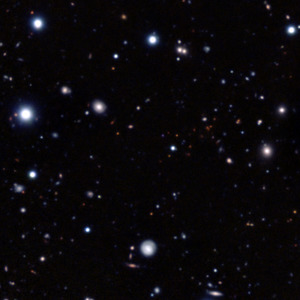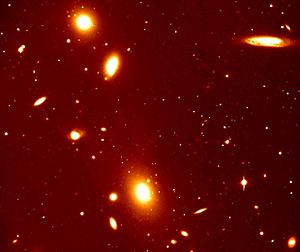Galaxy cluster facts for kids

Imagine huge groups of galaxies, all held together by gravity. These are called galaxy clusters. They can have hundreds or even thousands of galaxies, much bigger than smaller galaxy groups like our own Local Group.
It's important not to mix them up with star clusters (which are groups of stars inside a galaxy) or globular clusters (which usually orbit a galaxy).
Some famous galaxy clusters near us include the Virgo Cluster (where our Local Group is!), the Fornax Cluster, the Hercules Cluster, and the Coma Cluster.
Even bigger than galaxy clusters are superclusters. One huge collection called the Great Attractor, led by the Norma Cluster, is so massive it actually pulls on everything around it, affecting how the universe expands.
Far away in the early universe, scientists found a very massive cluster called SPT-CL J0546-5345. When we look at distant objects, their light is stretched, which is called redshift.
Contents
What are Galaxy Clusters Like?
Galaxy clusters usually have these features:
- They contain between 50 and 1,000 galaxies.
- They also have very hot gas that glows with X-rays.
- A lot of their mass is made of something mysterious called dark matter.
- These three parts (galaxies, hot gas, and dark matter) are spread out in a similar way throughout the cluster.
- A typical cluster can weigh as much as 100 trillion to 1,000 trillion times the mass of our Sun.
- They are huge, usually 2 to 10 million light-years across. (A parsec is a unit of distance used in astronomy).
- The galaxies inside a cluster move very fast, about 800–1000 kilometers per second.
- The gas between the galaxies, called the intracluster medium (ICM), is super hot, around 7 to 9 keV (kiloelectronvolts). This is a way to measure energy or temperature.
What are Galaxy Clusters Made Of?
Galaxy clusters have three main parts:
| Part of the Cluster | How Much Mass It Has | What It Is |
|---|---|---|
| Galaxies | 1% | These are the parts we can see with telescopes, like our own Milky Way galaxy. |
| Gas between galaxies | 9% | This is super hot plasma (a gas where atoms have lost their electrons) that fills the space between galaxies. It's so hot it gives off X-rays. |
| Dark matter | 90% | This is the biggest part of a cluster, but we can't see it directly. We know it's there because of its strong gravity, which pulls things together. |
How Big is Everything in Space?
Here's how things fit together, from biggest to smallest:
Universe > observable universe > very large structures > superclusters > galaxy clusters > galaxy groups > galaxies > star clusters > stars
Images for kids
See also
 In Spanish: Agrupación galáctica para niños
In Spanish: Agrupación galáctica para niños




